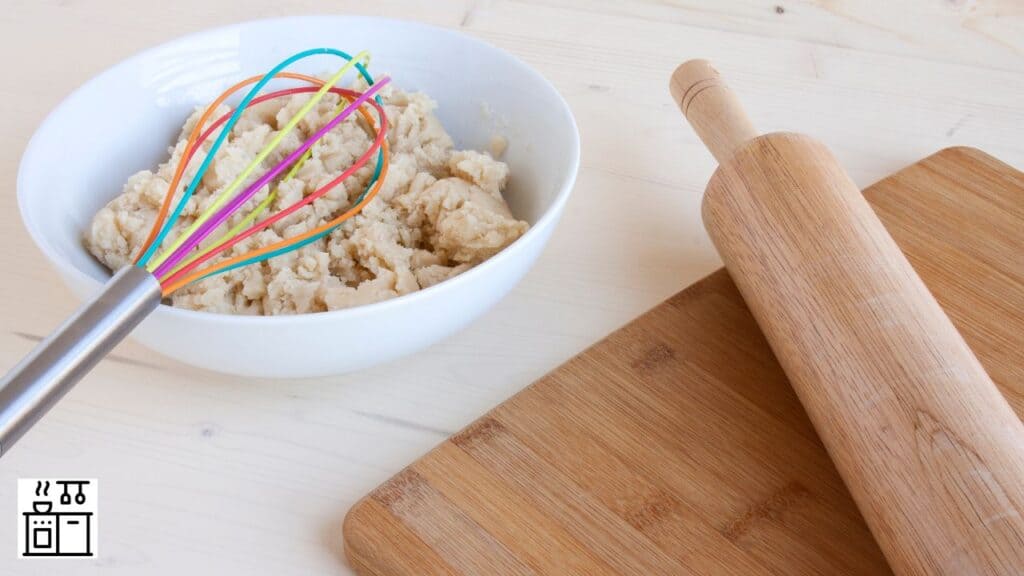Cookie dough is usually meant to be a little sticky from the gluten in the flour.
However, it can be very frustrating if the dough turns out to be too sticky.
It’s difficult to work with sticky cookie dough, and the cookies can turn out to be flat and hard.
So, what makes cookie dough too sticky?
Let’s find out.
Reasons for Cookie Dough to Be Too Sticky
It’s a pain to work with cookie dough that is too sticky.
Hence, it’s better to avoid sticky cookie dough in the first place.
For this, let’s look at what makes cookie dough too sticky.
1. The Dough Is Too Warm
Cookie dough recipes include wet and sticky ingredients like eggs, butter, and milk.
These ingredients hold up well in the refrigerator.
But their texture changes when you bring them to room temperature.
Many cooks don’t account for this factor when measuring ingredients for their dough.
So if a recipe uses many sticky ingredients, you can end up with a heavy dough.
If you use the ingredients directly out of the refrigerator, the dough may look fine at first.
However, the longer you keep it at room temperature, the more likely it will become sticky.
2. Problem with Certain Ingredients
Some ingredients, like eggs or bananas, aren’t easy to measure.
So having these ingredients in a cookie recipe may cause differences in the texture.
It’s because these ingredients are wet. The amount of liquid they add to the recipe depends on their size.
If you mix up the quantities of the wet and dry ingredients, the texture of the dough changes.
This can make the dough sticky and difficult to mold.
So you may end up with a dough that is too sticky if you use bigger eggs instead of small ones for the same recipe.
3. Slip-Up in Measurements
Cookie recipes aren’t an exact science. They allow for error to a certain extent.
Nonetheless, you can’t just put the ingredients together in any ratio.
When recipes require accurate measurements, it’s important to follow instructions.
Small changes like replacing softened butter with melted butter can change the texture of the dough.
You should also be careful while changing volume measurements into weight and vice-versa.
To reduce errors, measure wet ingredients by volume and dry ingredients by weight.
4. Overmixing
Most cookie recipes use refined or processed flour.
Flour contains gluten which adds elasticity to a dough when you knead or mix it with water.
Now, gluten is often the culprit behind sticky dough. The more you mix the dough, the more gluten is formed.
Hence, it can make the dough stickier.
Wet ingredients can also make the dough sticky when overmixed.
Ingredients like butter and coconut oil solidify in the refrigerator.
When you knead them too much into a dough, they become liquids.
This change in texture will make the dough runnier than expected.
So avoid overmixing ingredients for recipes that can end up being too sticky.
The good news is that you can fix the problem if this happens.
Just chill the dough for a short while, and these runny ingredients will turn hard.
How to Fix Cookie Dough that Is Too Sticky?
Dealing with sticky cookie dough isn’t fun. Fortunately, you can fix the problem.
Let’s look at some of the simple ways to fix sticky dough and make it right for baking.
1. Chill the Dough

One of the easiest ways to fix sticky cookie dough is by chilling it. Chilling the dough makes the butter harden.
So the flour will absorb the moisture from the dough, and it will be easier to handle and mold.
Some cookie recipes require chilling even otherwise.
If your dough is too sticky, extend the duration of chilling.
You can chill the dough for at least an hour before rolling it. This will make it much easier to work with.
If the dough is too sticky, refrigerate it overnight in an airtight bag or container.
This will harden the dough and make it more malleable.
You should act fast once you take the dough out of the fridge.
The dough will loosen and become soft the longer you keep it outside.
So we recommend taking it out in batches instead of using all the dough at once.
This will give you enough time to roll it out and make cookies before it reaches room temperature.
2. Add More Flour
We already saw that cookie dough becomes sticky because of extra wet ingredients.
The easiest fix for this problem is to add more flour to the dough.
Add extra flour to the sticky dough gradually to reduce its stickiness.
We recommend adding just one tablespoon at a time.
It will help you adjust the texture without the dough becoming too dry.
Adding too much flour can make the dough dry and difficult to roll out.
It can also make the cookies dry and tasteless.
So stop adding flour once the dough is just the right texture to roll out.
3. Add More Dry Ingredients
Cornstarch absorbs moisture without altering the taste of cookies.
If your dough is just sticky, you can add cornstarch instead of additional flour.
It will soak the extra moisture without becoming too dry.
However, cornstarch isn’t the best remedy for dough that is too sticky. You will have to use other ingredients.
For oatmeal cookies, increase the quantity of oatmeal in the recipe.
Oats will absorb moisture and thicken the dough.
Other ingredients that absorb moisture and help the dough stiffen include coconut, cocoa powder, and sugar.
4. Coat with Sugar
If you got your measurements all wrong and the dough is too wet, you can still rescue it.
It may be impossible to roll out dough that is too wet. However, you can use it in another way.
Roll out the dough into tiny balls. Then, coat the cookie balls with powdered sugar.
The sugar will hold the dough together and make it easier to handle.
Another advantage of this method is that the cookies will not lose their original flavor.
They will just be a little sweeter.
However, the addition of sugar can alter the taste of some cookies, like chocolate chip cookies.
But it works just fine for most other types of cookies.
5. Double the Recipe
This is one of the best ways to fix the problem if you have accidentally used too many wet ingredients.
Your cookie dough can become very runny if you added too much butter or milk.
Rather than trying to fix it by adding more dry ingredients, double the recipe.
Add all the other ingredients to make twice as many cookies.
This will make it easier to adjust the consistency of the dough.
It will also prevent the cookies from losing their expected flavor.
If you end up with more dough than you need, refrigerate or freeze the excess.
Most types of cookie dough will hold up in the refrigerator for three to four days.
It will last much longer, for several weeks, in the freezer.
Related: A Step-By-Step Guide to Bake Frozen Cookie Dough
6. Dry the Cookie Dough
If nothing else works, try drying the cookie dough in the oven.
But this isn’t a very reliable method because you don’t have much control over the outcome.
To dry the dough, set the oven to the lowest temperature.
Then, spread the mixture on a tray and put it in the oven.
Cook the dough for several minutes till the oven draws the moisture out of it.
The main risk of this method is that the dough can end up cooking in the oven.
So you should continuously monitor it to stop the drying process at the right time.

